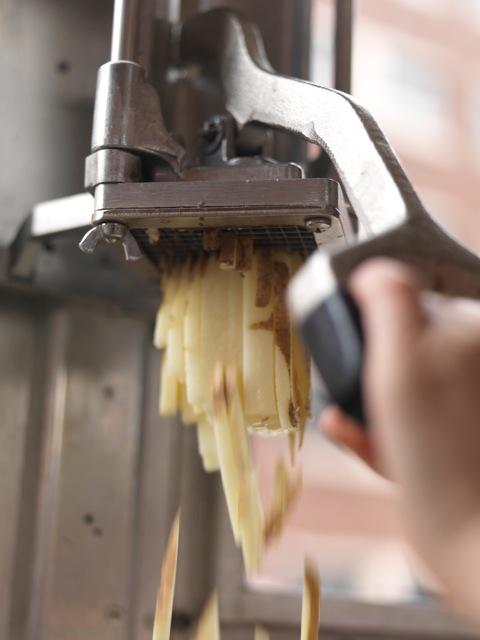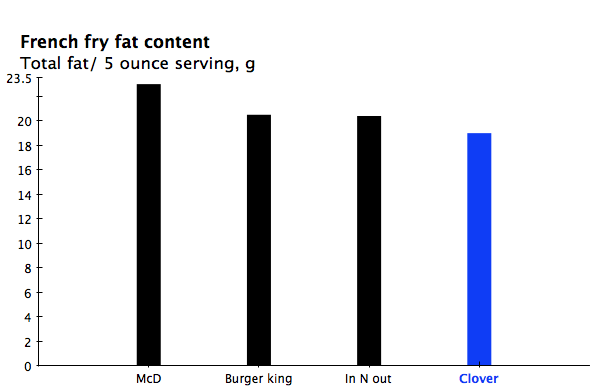
I still owe you all the nutritionals on the Egg and Eggplant and the soy BLT. I’ll get those up soon, but to tide you over, here are the french fries.
We sent out a couple samples of our fries, cut, soaked, drained, fried, salted just as we always do. Besides being cut on the truck, our fries have a few other unusual qualities. When Rolando and I got started trying to figure out how to make french fries we knew they weren’t going to be frozen. Most fries are called “Sysco fries” in the industry, Sysco is a large foodservice supplier.
We started with the methods most folks use (think Five Guys, good French Bistros). This involves par cooking the potato. We’d heard certain people spend a lot of time bragging about their oil, so we thought that cracking this thing was going to be all about finding the right oil.
We found instead that, like almost everything, it’s about the starting ingredients. In this case: the potato. In my opinion oil matters very little. First you need to get the best potato, then the question is how fresh/ how do you cut, after that temperature and time, finally, very last on the list is oil.
I remembered some of my favorite fries of all time were from a street vendor in Halifax, Nova Scotia. The funny thing was, as I thought about it, he cut them there and didn’t par cook the fries. Par cooking means cooking at a lower temperature before a later cooking phase. In the case of fries potatoes are often par cooked with a low temperature oil. After this phase they are cooked through and limp and oily. Then later (sometimes 20 minutes, sometimes an hour) they are cooked at a higher temperature. This results in a well cooked potato that is very crispy on the outside.
We followed the lead of the Halifax street vendor. Our fries are not par cooked. We cook them once at a high temperature. I suspected this meant that the fries would have less oil in them at the end, and the tests prove that out. Theory holds that the steam coming out of the potatoes holds the oil at bay. In N Out also cooks once, but they cook at a very low temperature for a very long time. This has the opposite effect. Their fries are saturated with oil.

Clover fries:
400 kcal
19 g fat
6 g protein
50 g carbohydrates
UPDATE: I was getting a ton of flak for the graph format. For the record, It’s not “wrong” to show a graph with a Y-axis minimum other than zero. It’s not super common in engineering etc., but in the business world it’s very common when differences between measurements vary by less than 10 or 20% of the total (making it hard to see the difference on a zero axis).
That said, I can see that the previous chart was misleading. In my defense, I wasn’t meaning to mislead anybody! I was giving this new graphing software: OmniGraphSketcher a spin. If you can get past the name it’s pretty cool software. Basically does everything I always wanted graphing software to do, except that it doesn’t support a bunch of advanced stuff I’d like. I went with their default representation of the data. Changed now for clarity.

